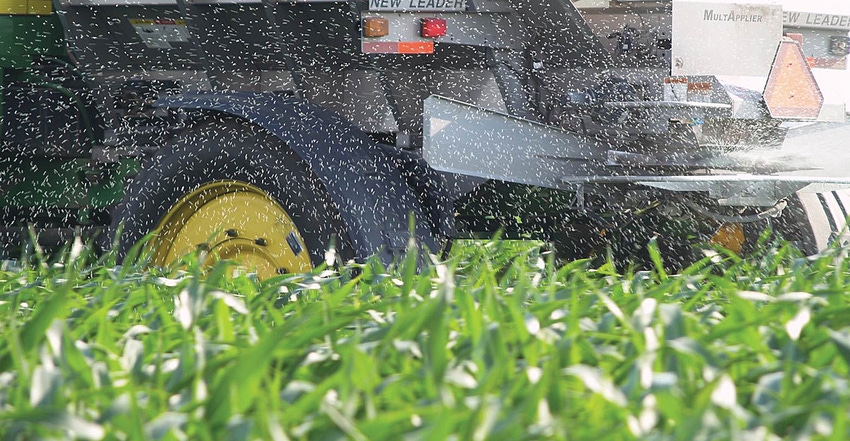October 3, 2017

By Kyle Haselman
Every farmer out there at some point spreads inputs on his or her field. Many times, the grower just goes up to the local cooperative and hooks up to whatever spreader is in line and heads off to the field without ever thinking about the quality of the job that spreader will do. I spent many years in the ag retail world, and many times when a new spreader is purchased, it may get calibrated one time for one product when it’s new and never touched again. It’s not the case everywhere, but more often than not it happens that way.
What affects spread pattern?
One of the biggest issues affecting spread pattern is spinner speed and swath width. Just because a spreader says 50 feet on the front doesn’t mean that it does it uniformly or accurately.
Many growers are starting to buy their own units and looking for a do-it-all multiple-product spreader. I hate to say it, but one does not truly exist that does well on all products. There is give-and-take with all the spreaders on the market.
When spreading dry fertilizer, you want a narrower opening and steeper slopes for better cleanout so that the flow can be channeled down and directed more to a specific location on the spinners. As you move up the ladder to lime and gypsum materials, the flow rates are much higher, and moisture content and ability to flow become an issue. The wider the opening the less control you have on drop location of spinners effecting spread pattern. The steeper the sides are, the better it will handle wetter limes or out-of-condition lime from stockpiles.
To go one step further to poultry litter or manure spreaders, they often do well at spreading dry material in large volumes, or great with wet material. But they don’t do well with lower rates around 1 ton per acre or less for lime and gypsum.
How do you control application rate?
The amount of product being applied and how far off rate the application is another problem that I see happening far too frequently. Having a scale kit added to a spreader of any type is the best solution a grower can make. If a scale kit isn’t added on, you can get a set of portable scales and weigh each axle of loads every so often.
When a scale is added you know how many pounds per acre are getting applied in a relatively short time period. This allows growers to make corrections to either calibration factors or gate openings quickly rather than getting to the end of field and either being too short or too long on product. With the current crop price environment, growers can’t be relying on a chart sticker at the back of a spreader to tell them where to set the opening. Scales also provide a sense of security and assurance that the correct amount of product was delivered or purchased.
How do you check spread pattern?
Calibration of spreader is often overlooked and often not done repeatedly. As spreader age and parts wear, the spread pattern often shifts with time. To do spread pattern checks, it really doesn’t require all that much to do. Five or more 9-by-13-inch aluminum baking pans, a couple of clear plastic test tubes and a tape measure are all that is needed. Arrange the pans across the full spread width and make a pass or two. Every spreader manufacture has calibration adjustment that can be made to shift the pattern one way or another.
In the end, you want to have a nice bell-shaped pattern that allows for some overlap as spreaders are designed to spread slightly wider than the actual spread width. Refer to each manufacture’s guideline on adjustments, but take the time to actually do it rather than finding green streaks in the field later.
How do I control spinner speed?
One of the other misleading and often overlooked issues in calibration and spreading is the actual spinner speed. The spinner speed plays a key role in pattern shape and can be used to adjust pattern down to proper shape. Just because a spreader can throw fertilizer or material 80-plus feet doesn’t mean it is doing it properly in a good pattern.
Often operators run PTO-driven spreaders at too fast when they were designed to be run at a given rpm, often at three-quarter’s throttle or similar. Buying a cheap tachometer or mounting a speed sensor of some kind on the spinners will help improve spread pattern greatly if you take the time to calibrate it. Many of the old fertilizer spreaders were designed to run around 400 rpm, while some of the new spreaders on the market are set to run close to 1,000 rpm. Read through your manual and calibrate your machine on a routine basis.
Taking the time to set up and check settings once a year or more can provide huge savings in product and place the material where it was intended. Agronomists make recommendations for product to be applied at the right rate and right place, so do you part to ensure it ends up there.
Haselman is a certified crop adviser at Haselman Ag Management in Leipsic, Ohio. Visit haselmanag.com, or email [email protected].
You May Also Like




